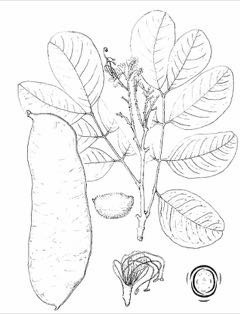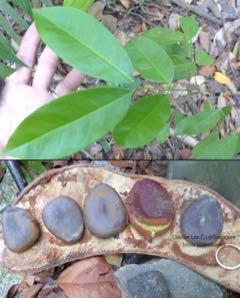 |
|
http://www.edibleplants.org |
 |
| asianplant.net |
Translate this page:
Summary
Intsia palembanica or commonly known as Borneo Teak is a tree growing up to 50 m tall with trunk diameter of up to 120 cm. It can be found in forests in East Asia. Young seeds are edible. The bark and wood yields brown and yellow dyes used for coloring mats and clothes. The wood is heavy, hard, strong, durable and resistant to fungi, wood borers, and termites. It is used for high-grade construction work, interior finishing, panelling, parquet flooring, furniture, etc.
Physical Characteristics

 Intsia palembanica is an evergreen Tree growing to 80 m (262ft) by 60 m (196ft) at a slow rate.
Intsia palembanica is an evergreen Tree growing to 80 m (262ft) by 60 m (196ft) at a slow rate.
See above for USDA hardiness. It is hardy to UK zone 10. The flowers are pollinated by Bees, Insects.
It can fix Nitrogen.
Suitable for: light (sandy) and medium (loamy) soils and prefers well-drained soil. Suitable pH: mildly acid, neutral and basic (mildly alkaline) soils and can grow in very acid soils.
It cannot grow in the shade. It prefers dry or moist soil and can tolerate drought. The plant can tolerate maritime exposure.
UK Hardiness Map
US Hardiness Map
Synonyms
Afzelia bakeri Prain Afzelia palembanica (Miq.) Baker Intsia bakeri (Prain) Prain Intsia plurijuga H
Plant Habitats
Edible Uses
Edible Parts: Seed
Edible Uses:
Young seeds are sometimes eaten[310 ].
References More on Edible Uses
Medicinal Uses
Plants For A Future can not take any responsibility for any adverse effects from the use of plants. Always seek advice from a professional before using a plant medicinally.
Bark and leaves are used medicinally[310].
References More on Medicinal Uses
The Bookshop: Edible Plant Books
Our Latest books on Perennial Plants For Food Forests and Permaculture Gardens in paperback or digital formats.

Edible Tropical Plants
Food Forest Plants for Hotter Conditions: 250+ Plants For Tropical Food Forests & Permaculture Gardens.
More

Edible Temperate Plants
Plants for Your Food Forest: 500 Plants for Temperate Food Forests & Permaculture Gardens.
More

More Books
PFAF have eight books available in paperback and digital formats. Browse the shop for more information.
Shop Now
Other Uses
Dye Furniture Wood
Other Uses: Brown and yellow dyes are obtained from the bark and wood[46 , 310 ]. They are used for colouring mats and clothes[46 ]. The heartwood is orangey-brown, becoming dark red-brown or dark brown when exposed to the light; it is clearly demarcated from the 5 - 8cm wide band of white or pale yellow sapwood. The texture is coarse but even; the grain interlocked or wavy. The wood is heavy; hard to very hard; strong; durable, being resistant to fungi and dry wood borers, and moderately resistant to termites and ocean water. It seasons slowly, with only a slight risk of checking and distortion; once dry it is stable in service. The wood works well but has a fairly high blunting effect, stellite-tipped and tungsten carbide tools are recommended; nailing and screwing are good, but require pre-boring; gluing is correct; the wood takes a very fine polish. It is used for high-grade construction work, interior finishing, panelling, parquet flooring, furniture, railroad ties and beams[46 , 661 , 848 ].
Special Uses
Nitrogen Fixer
References More on Other Uses
Cultivation details
A tree of the moister lowland tropics found most commonly near sea level, though it can succeed at elevations up to 450 metres[303 ]. It grows best in areas where the minimum temperature does not fall below 17°c and the maximum is no higher than 33°c[303 ]. It is susceptible to frost[303 ]. It tolerates an annual rainfall in the range of 1,500 - 2,300 mm[303 ]. The following notes are taken from Intsia bijuga, and are likely to be more or less true for this species. Prefers a position in full sun[307 ]. Prefers a very well-drained soil[307 ]. Plants are very tolerant of saline soils and salt-laden winds[303 , 307 ]. Established plants are moderately drought tolerant[303 ].
References Carbon Farming Information and Carbon Sequestration Information
Temperature Converter
Type a value in the Celsius field to convert the value to Fahrenheit:
Fahrenheit:
The PFAF Bookshop
Plants For A Future have a number of books available in paperback and digital form. Book titles include Edible Plants, Edible Perennials, Edible Trees,Edible Shrubs, Woodland Gardening, and Temperate Food Forest Plants. Our new book is Food Forest Plants For Hotter Conditions (Tropical and Sub-Tropical).
Shop Now
Plant Propagation
Seed
Other Names
If available other names are mentioned here
Borneo Teak, Merbau
Native Range
TROPICAL ASIA: Indonesia (Papua), Papua New Guinea, India (Andaman and Nicobar Islands), Myanmar (south), Thailand, Indonesia (Kalimantan, Sulawesi, Maluku, Sumatera), Malaysia, Philippines
Weed Potential
Right plant wrong place. We are currently updating this section.
Please note that a plant may be invasive in one area but may not in your area so it's worth checking.
Conservation Status
IUCN Red List of Threatened Plants Status : This taxon has not yet been assessed

Growth: S = slow M = medium F = fast. Soil: L = light (sandy) M = medium H = heavy (clay). pH: A = acid N = neutral B = basic (alkaline). Shade: F = full shade S = semi-shade N = no shade. Moisture: D = dry M = Moist We = wet Wa = water.
Now available:
Food Forest Plants for Mediterranean Conditions
350+ Perennial Plants For Mediterranean and Drier Food Forests and Permaculture Gardens.
[Paperback and eBook]
This is the third in Plants For A Future's series of plant guides for food forests tailored to
specific climate zones. Following volumes on temperate and tropical ecosystems, this book focuses
on species suited to Mediterranean conditions—regions with hot, dry summers and cool, wet winters,
often facing the added challenge of climate change.
Read More
Expert comment
Author
Miq.
Botanical References
1
Links / References
For a list of references used on this page please go here
A special thanks to Ken Fern for some of the information used on this page.
Readers comment
| Add a comment |
|
If you have important information about this plant that may help other users please add a comment or link below. Only comments or links that are felt to be directly relevant to a plant will be included. If you think a comment/link or information contained on this page is inaccurate or misleading we would welcome your feedback at [email protected]. If you have questions about a plant please use the Forum on this website as we do not have the resources to answer questions ourselves.
* Please note: the comments by website users are not necessarily those held by PFAF and may give misleading or inaccurate information.
To leave a comment please Register or login here All comments need to be approved so will not appear immediately.
|
Subject : Intsia palembanica
|
|
|
|